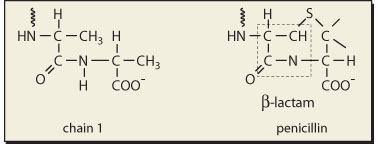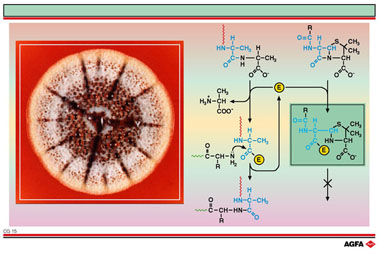CG15 Penicillin: co-operation with moulds is worthwhile !
| Aim:
To give an example of the molecular background of an antibiotic. |
Penicillin
was discovered in 1928 by the Scottish bacteriologist, Fleming. Antibiotics
of the penicillin family affect the biosynthesis of the cell walls of
certain bacteria.
During this biosynthesis two polypeptide chains of the peptidoglycanes
of the cell wall are bonded together by a peptide bond. This bonding is
catalysed by a transpeptidase enzyme. Penicillin blocks this reaction
by irreversibly inhibiting the enzyme.
In a normal situation (left) the enzyme forms a peptide bond with an amino group on chain 1 (red on the drawing) and a terminal alanine is split off. Chain 2 (green on the drawing) then forms a peptide with chain 1, with the enzyme splitting away (2x transpeptidase reaction).
In the presence of penicillin (right), which strongly resembles the alanine end of chain 1 (ß-lactam-structure), the enzyme bonds with the penicillin. The enzyme is thus blocked and can no longer act as a catalyst during the cell wall formation.

